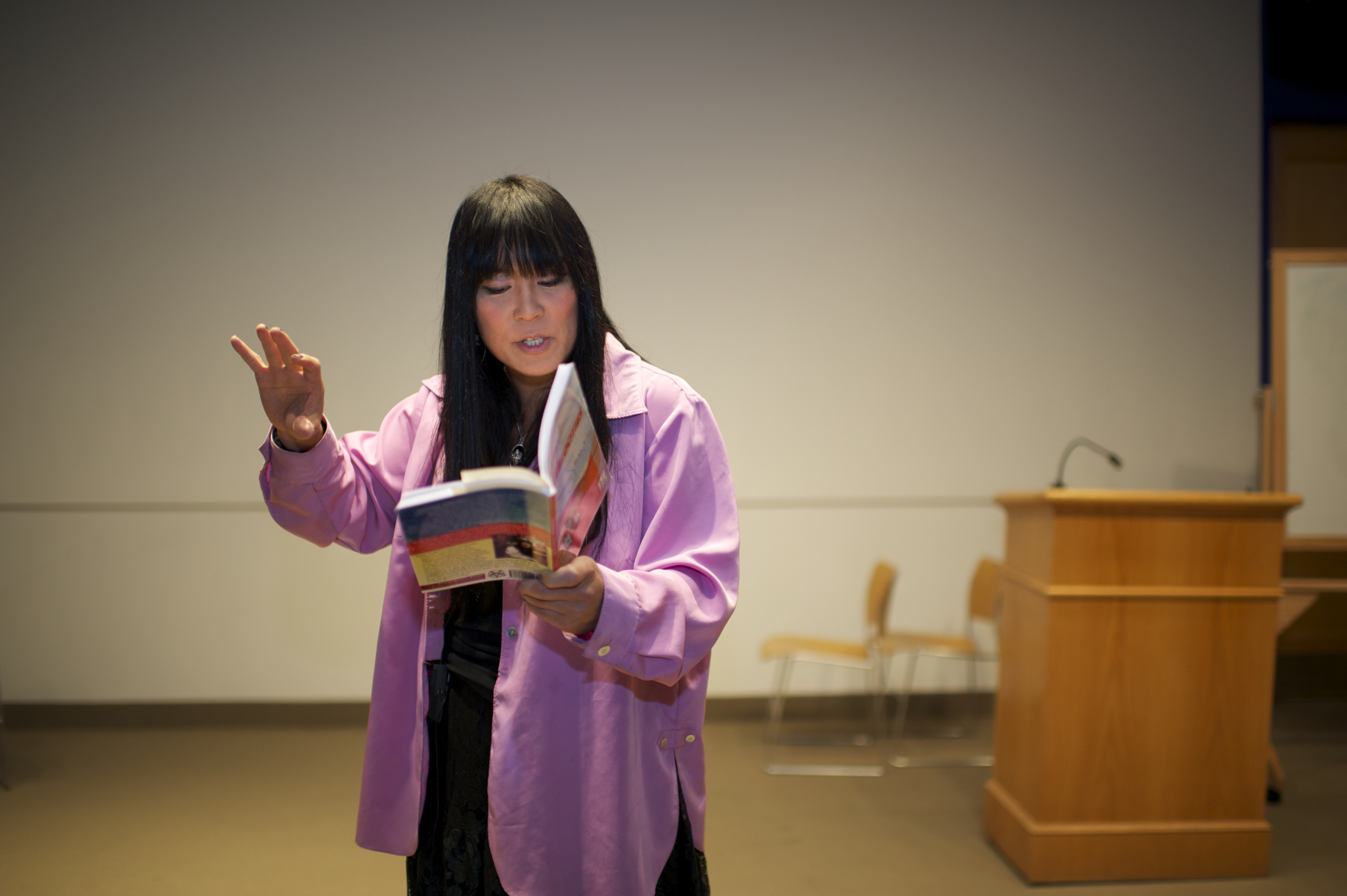 Author Ryka Aoki reading her work
Author Ryka Aoki reading her work
You are more than your trans self: Ryka Aoki's He Mele A Hilo
By Emma Caterine
As the confetti falls, lights fade on JUNIOR and the sound of typing. FAITH, in a white laced Filipiniana Wedding gown, enters to introduce the members of HER wedding party. FAITH: I am Faith Sia-Lippin, born the day bombs fell on Manila and Pearl Harbor. -“When the Purple Settles” by Francis Tanglao-Aguas
April 18th, 2012
I walked into the office of one of my favorite professors, Professor Francis Tanglao-Aguas, at the college I was soon to graduate from. He had called me in to tell me I was winning an academic award. But he gave me three gifts in that room on that day that have served me far better than the academic award.
“You should go to the Philippines,” he told me, smiling in a go-ahead-and-tell-me-what’s-on your-mind kind of way, which from most people feels so fake, but from him feels so earnest.
Francis realized I didn’t understand what he meant and added, “You would like it. Or at least find it interesting how gender there is treated so differently. Especially transgender people. But also, there is so much masculinity. That Spanish influence.” He talks like a playwright, each bit of dialogue forwarding a plot we were all in but that only he could see the end of. Francis paused, building up the dramatic irony to his audience of self:
“I want to give you some advice.”
I was an insolent anarcho-insurrectionist, a queer 21-year-old trans woman living in the South. Thinking I was above advice and criticism was a survival mechanism, a way for me to pretend that they didn’t hate me because I was some weird faggy man in a dress but because I was on some higher plane of ethical and intellectual existence.
“Of course,” I said, confident I already knew whatever he was going to say. After all, this was the professor who assigned Pedagogy of the Oppressed and was well-versed in a plethora of gender, race, and queer subjects.
So I was thrown off when he said to me, “You are more than your trans self.” And then a deluge of emotions: anger, hurt, and indignation swelled within my rash mind. How dare he belittle my focus on trans issues? How dare he belittle the oppression I face? I was particularly vulnerable at this time as a newly-out trans woman, but I hadn’t realized just how vulnerable until this bombshell. My walls of mental defense and the lies I lived on cracked: I filled them up with plaster quickly and they wouldn’t be torn down for another year, but it had begun. I don’t know if I could ever state definitely that one moment was the ‘most important of my life’ but this one certainly altered the course I was on completely. The idea of my life centered solely around being a trans woman and the liberation of trans women was dropped, swallowed, into a newly realized depth of my own essence that I was so terrified of, I had replaced it with this singular idea of trans-ness.
I never would have imagined such a powerful and unique moment could be replicated in a novel. A moment lived out in reality by people but of a significance that reaches beyond the space and time they inhabit. My taste in novels leans towards surrealism, whether in the hefty prose of William Faulkner or the unreliable perspectives of the characters and narrators of Nella Larsen. I don’t expect these kinds of texts to confront the actualities of my life in precise ways. But Ryka Aoki’s new novel He Mele A Hilo: A Hilo Song takes place on the borders between reality and fantasy; it provides a moment so intensely similar to my own life that it left my jaw agape and my mind full of questions about myself and the very ideas of power and privilege.
A rash reader could confine Aoki within the genre of magical surrealism alongside authors like Toni Morrison and Randall Kenan. But this genre’s distinctly American mainland flavor does not wholly encompass the entirety of what Aoki accomplishes in He Mele A Hilo. Aoki’s magical surrealism draws not just on personal and social historic memory but goes beyond to also be invested in the huperouranios topos (Plato’s “place beyond heaven” where a perfect Form of all things is found) of food, mythology, music, and dance. But unlike Plato’s Forms, they don’t stand as separate ideals but are all mixed together: characters taste music, hear both Jesus and Pele, dance in perfectly cooked chicken. Aoki engages all of your senses with her portrait of Hawaii. Emotions, visions, ideas, dreams, and plain reality all occupy the space of this world simultaneously. Never before have I more definitively felt I was experiencing a place through art.
What I perceive as the key to this immersing is Aoki’s ability to use concise diction to evoke complexity in every realm of the book, from the personalities of the characters to the dishes like the Crazy Omelet:
The Crazy Omelet had seven ingredients, each requiring its own marinade and unique, distinctive cut. For example, the Spam had to be sliced shoestring style, in long, thin segments. Simply chopping it wouldn’t do. The celery was to be julienned, then steamed. And the canned mushrooms had to be chopped into cubes. Any deviation would cause his Uncle to go into a tirade about how this was his signature dish, and how it put his restaurant on the map.
Aoki then builds on this introduction to tell a story about pride, family, and truth. The book, while generally chronologically linear – give or take a few flashbacks – is not a succession of stories but a tapestry of life as we actually experience it: unlimited stories occurring simultaneously, beginning and ending and crossing and destroying each other and combining to become larger or splitting off to become smaller. For too long terrible racist and misogynist author Sherwood Anderson has been held as the master of the form of novel that uses a collage of short stories to create a story arc. But Aoki is not doing a better version of Winesburg, Ohio: she is completely pushing the limits of the novel form. And yet, it was easy to read and comprehend every aspect of the plot. Aoki’s story weaving is so quick and seamless that it creates a literary phenakistoscope.
A phenakistoscope is an early animation device that uses a disk of sequential images spun to produce the illusion of motion. Aoki’s literary phenakistoscope creates the illusion of a single story arc, the most common movement of novels and thus most comfortable to most American readers. But when we deconstruct He Mele A Hilo, we see that the book is written as multiple ‘snapshots’ of the lives of the characters that proceed in such quick succession as to create the same illusion of movement that the phenakistoscope does: our minds seamlessly filling in whatever empty spaces exist. This structure allows Aoki to give completely of the lives of far more characters than most authors can include without confusing the reader. It is an amazing literary achievement to say the least and from what I have learned from the book itself a distinctly Hawaiian one.
A glossary is included in the back of the book for haoles (“Caucasian. Can be neutral or pejorative, depending on context, or the haole.”) like me, but I never once felt the need to use it while reading the book. The many languages found in Hawaii and the island’s slang manifested meanings in their circumstances, like studying a language abroad. And I’m not just any haole either: my knowledge of Hawaii was pretty much limited to the music of Bruddah Iz, a paragraph or two from histories of colonialism and resistance, and Janet Mock’s Redefining Realness. Not to mention the terrible stereotypes ingrained in our mainland American heads by television and advertisements. But He Mele A Hilo is not a book written for white people to understand Hawaii: it’s more about another idea, one captured by Senegalese filmmaker Ousmane Sembène who said, “We had to see, feel, and understand ourselves through the mirror of film…in a struggle against all the ills of man’s stupidity, envy, individualism, the nouveau rich mentality, and all the things we have inherited from the colonial and neo-colonial systems” (in The Cinema of Ousmane Sembene).
Aoki’s Indigenous characters are far from perfect (and often far from wholly Indigenous), the major conflicts that arise in the novel are often rooted in the actions of the descendents of settler colonialists or the practitioners of neo-colonialism. And what makes this book so prescient and reflective of our modern neoliberal reality is how often those same people think they are helping or even saving those they actively hurt.
Professor Francis Tanglao-Aguas taught me about Ousmane Sembène and colonialism, but the most important thing he ever taught me was that simple statement “You are more than your trans self.” Though I once bristled, I can now look at art like Aoki’s and see my former professor’s advice in practice. Aoki is a trans woman of color author. Aoki is a Hawaiian author. Aoki is a masterfully innovative author. She is as full of identity in harmony as her book: I would like to one day be so conscious of who I am. Regardless of how the next steps come in my journey, they will be able to be traced back to a wise patient teacher and He Mele A Hilo.
Emma Caterine
Though Emma spends most of her time community organizing with Red Umbrella Project and writing non-fiction about police brutality and prison abolitionism, she also pens the occasional sci-fi story, memoir piece, or not-so-subtle mockery of Buzzfeed style articles (see Maximum RocknRoll #368).
Catch up with me @emmacaterine.

